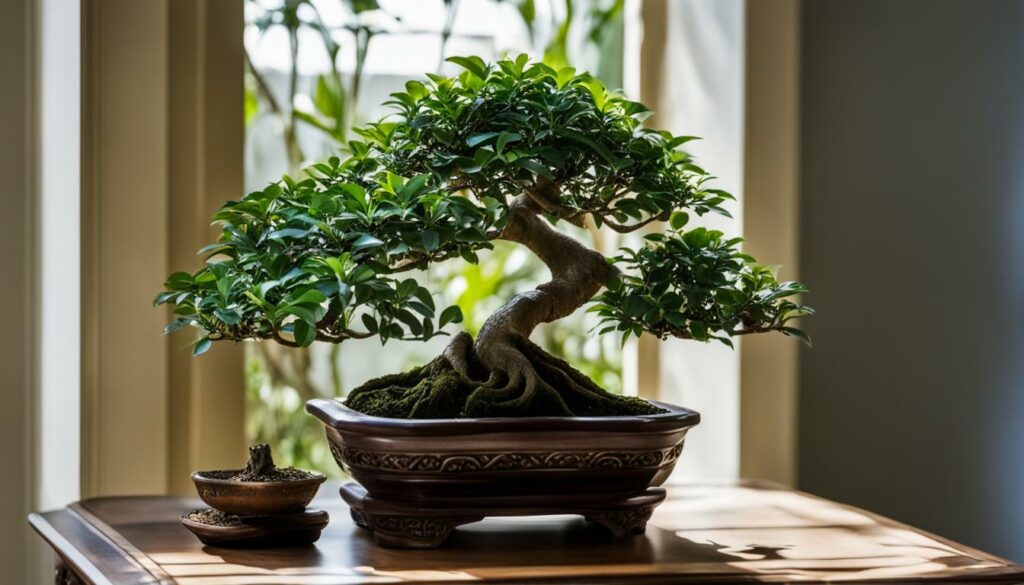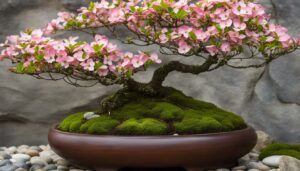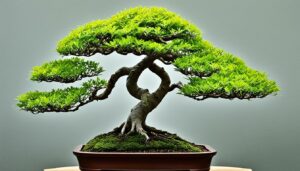Welcome to the world of Bonsai Tree Species Ficus! If you’re looking for a beautiful and fascinating addition to your indoor garden, you’ve come to the right place. Ficus bonsai trees are known for their versatility, making them an excellent choice for both novice and experienced growers.
In this section, we will take a closer look at the Ficus bonsai tree species. You will learn about the different types of Ficus bonsai trees, their unique features, and how to care for them to ensure they thrive in your home.
Key Takeaways:
- Ficus bonsai trees are a versatile and beautiful addition to any indoor garden.
- There are several types of Ficus bonsai trees with unique features, including the Ginseng Ficus and Fig bonsai.
- To care for your Ficus bonsai, it’s essential to pay attention to factors such as watering, lighting, pruning, and fertilizing.
- A ginseng ficus bonsai has thicker trunks and unique aerial roots, while a fig bonsai has a mature appearance with elegant foliage.
- With patience and dedication, you can cultivate a serene living art in your home.
Understanding Ficus Bonsai Care
Proper care is essential for your indoor bonsai to thrive. Ficus bonsai care requires attention to watering, lighting, pruning, and fertilizing.
Watering Your Ficus Bonsai
The best way to water your indoor bonsai is to monitor the soil. Check the soil every day by touching the surface. If it feels dry, it’s time to water. Keep the soil moist but not waterlogged. Overwatering can lead to root rot. Avoid wetting the leaves as this can cause fungal infections.
Lighting Needs of Ficus Bonsai
Ficus bonsai trees need bright, indirect light. Direct sunlight can lead to scorching of the leaves. Avoid placing your indoor bonsai near windows that receive direct sunlight. If necessary, use artificial lighting to supplement natural light.
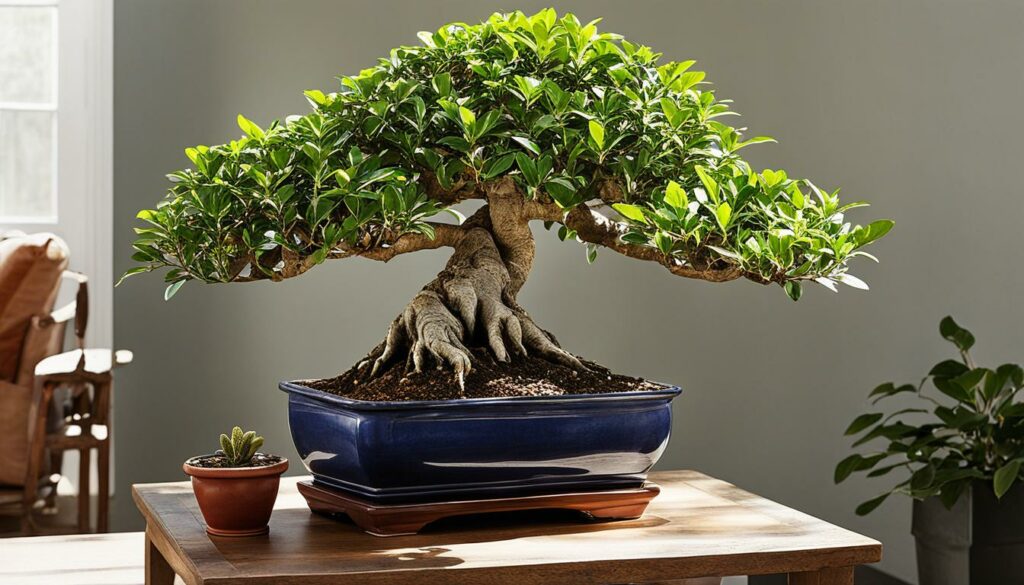
Pruning Your Ficus Bonsai
Regular pruning is necessary to maintain the shape and health of your Ficus bonsai. Prune during the growing season, removing no more than a third of the growth at a time. Pinch back new growth to encourage branching, and remove any dead or damaged foliage promptly.
Fertilizing Your Ficus Bonsai
Use a balanced fertilizer during the growing season to provide essential nutrients to your indoor bonsai. Fertilize every two weeks with a water-soluble fertilizer, following the package instructions. Avoid fertilizing during the dormant season.
“Proper care is essential for your indoor bonsai to thrive.”
The Ginseng Ficus: A Unique Bonsai Variation
If you’re searching for a standout addition to your indoor bonsai collection, the ginseng ficus is an excellent choice. With its eye-catching aerial roots and thick trunk, this particular species of Ficus bonsai stands out from the crowd. Its distinctive appearance makes it a popular choice among bonsai enthusiasts who want to showcase a unique beauty in their home.
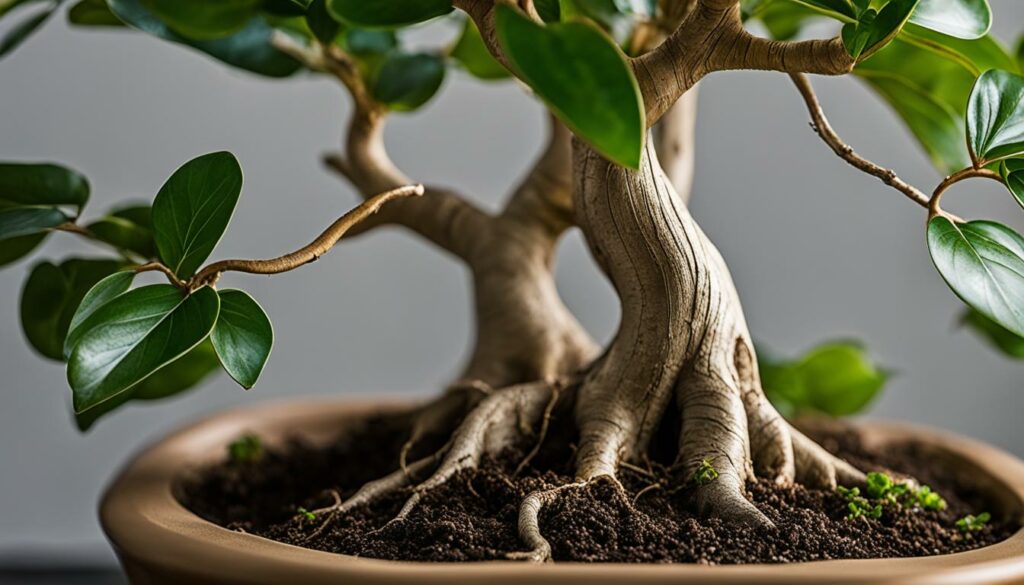
Like other Ficus bonsai, the ginseng ficus requires consistent care to thrive as an indoor bonsai. Proper watering and humidity levels are crucial to maintain its health, and it prefers bright, indirect light. However, unlike other species, the ginseng ficus can tolerate lower light conditions, making it a versatile option for those with less sunny living spaces.
The thicker trunk of the ginseng ficus lends itself well to shaping, allowing for creative styling options that accentuate its unique character. But it’s important to be patient when pruning and wiring this variety, as its woody texture can make it more challenging to manipulate than other Ficus bonsai.
Overall, the ginseng ficus is a stunning and resilient indoor bonsai that is well worth the time and effort it takes to cultivate. With proper care and attention, you can create a striking centerpiece for any room in your home with the unique charm of the ginseng ficus bonsai.
Cultivating Fig Bonsai: A Timeless Art Form
Fig bonsai trees are not only a beautiful addition to any indoor bonsai collection but also a celebration of the rich history of bonsai cultivation. Appreciated for their mature and elegant appearance, these trees are a testament to the patience and dedication required to master the art of bonsai.
When cultivating fig bonsai, it is important to choose a tree that is already mature, with a developed trunk and characterful branches. Young fig bonsai trees can be challenging to shape and train, and are better left to experienced bonsai enthusiasts.
The first step to cultivating your fig bonsai is to establish its natural shape and structure. Use wire to gently shape the trunk and branches, taking care not to cause damage or breakage. The branches of your fig bonsai should resemble the natural growth patterns of the species, with a slightly drooping appearance that is characteristic of fig trees.
Aerial roots are an attractive feature of many fig bonsai trees, and can be encouraged by wrapping sphagnum moss around the base of the trunk and enclosing it in plastic wrap. This will create a moist environment around the trunk and promote the development of aerial roots. Be sure to regularly check the moss and adjust its moisture levels to prevent rotting.
Pruning is crucial to achieving the desired shape and size for your fig bonsai. By carefully removing excess branches and foliage, you will encourage strong and healthy growth and prevent your tree from becoming overcrowded or unbalanced.
When it comes to caring for your fig bonsai, remember that these trees can be sensitive to changes in their environment. Provide consistent moisture levels and avoid exposing your tree to harsh sunlight or extreme temperatures.
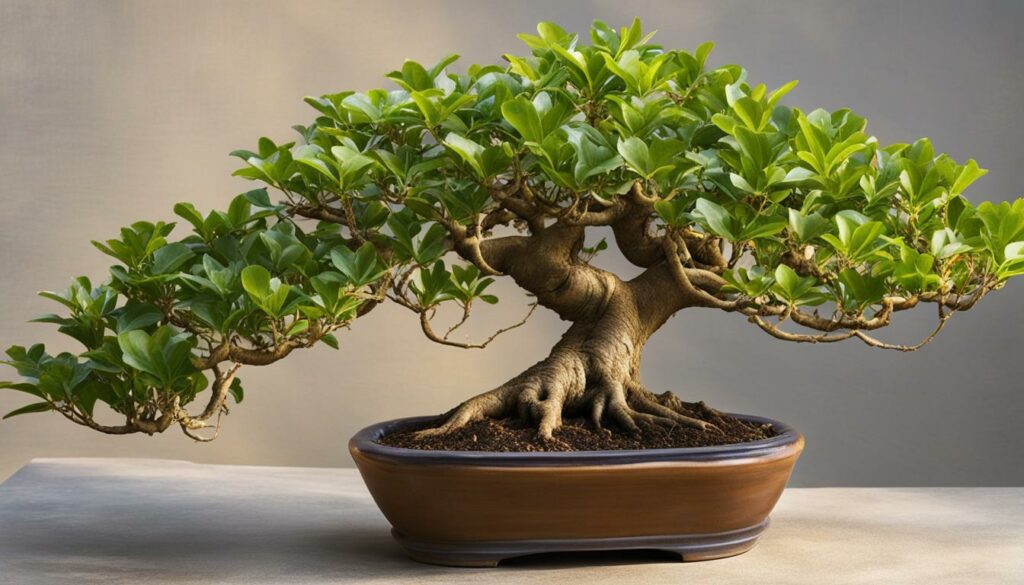
Tip: If you notice your fig bonsai losing leaves, it may be a sign that it needs more humidity. Consider placing a small humidifier near your tree or regularly misting its leaves with water.
Conclusion
Congratulations! You now have a comprehensive understanding of Bonsai Tree Species Ficus. By following the tips and techniques outlined in this article, you can successfully care for and cultivate your own indoor bonsai tree.
Remember, patience is key when it comes to bonsai. It may take some time to achieve the desired shape and style, but with consistent care and attention, your bonsai will flourish into a beautiful, living work of art.
Continue to research and experiment with different bonsai species and styles to create a unique and stunning display in your home. Enjoy the peaceful and rewarding experience of bonsai cultivation!
FAQ
What is a Ficus bonsai tree?
A Ficus bonsai tree is a miniature version of the Ficus tree, which is popular for its lush foliage and aerial roots. It is cultivated using specialized techniques to create a miniature, aesthetically pleasing tree in a bonsai pot.
How do I care for a Ficus bonsai?
Caring for a Ficus bonsai involves several important steps. It requires regular watering, but it’s important not to overwater it as it can lead to root rot. Ficus bonsai trees also need bright but indirect sunlight, and they thrive in temperatures between 60-85°F. Regular pruning and fertilizing are necessary to maintain its shape and health.
Can I keep a Ficus bonsai indoors?
Yes, Ficus bonsai trees can be kept indoors as long as they receive enough sunlight and are kept in an environment with a stable temperature. However, it’s essential to provide them with adequate humidity and proper ventilation to prevent common issues like pests and diseases.
What makes the ginseng ficus bonsai unique?
The ginseng ficus bonsai is known for its unique aerial roots and thick, bulbous trunk, which resemble the shape of the medicinal ginseng root. These distinctive features give the tree a characterful appearance and make it a popular choice among bonsai enthusiasts.
How do I care for a ginseng ficus bonsai?
Caring for a ginseng ficus bonsai is similar to other Ficus bonsai trees. It requires bright, indirect sunlight and regular watering, making sure not to let the soil dry out completely. Regular pruning and fertilizing are also necessary to maintain its unique shape and promote healthy growth.
What is the art of cultivating fig bonsai?
Cultivating fig bonsai involves precise techniques for shaping the branches, creating aerial roots, and achieving a natural-looking canopy. It requires artistic vision and careful pruning to achieve the desired form. Fig bonsai trees are admired for their mature appearance, dense foliage, and elegant curves.
